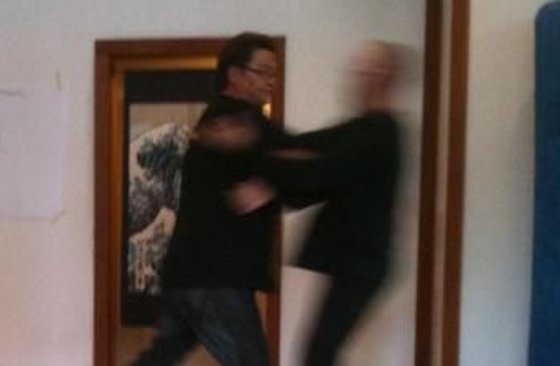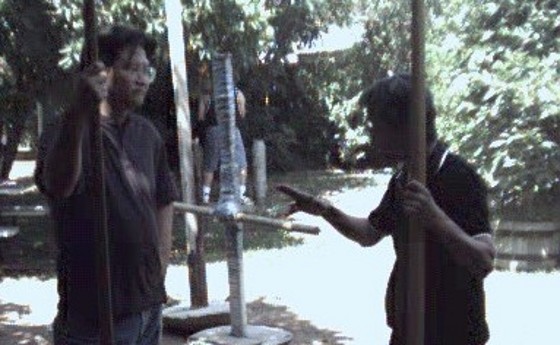
Wing Chun Masters: Gary Lam
January 27, 2013
“You know the meaning of Wing Chun? The meaning of Wing Chun is learn to take over your opponent’s position. Chinese, we say “seg wai.” Seg Wai is “I eat your position.” That means I take over your position. If I take over your position, I become you. You are controlled by me because you are out of balance already.”
Gary Lam
My student, he says, “Sifu, I hit the guy ten times, then he run away.” I say, “How can you hit him ten times and he can run away? You should tell me you hit him two times and he already sleep on the floor. OK, go and hit the sandbag five hundred times.”
Gary Lam
Gary Lam (Lam Man Hoc) is my Sigung (my teacher’s teacher).
He trained with the legendary Wong Shun Leung for over fifteen years and was Sifu Wong’s head coach for six. He won the Hong Kong full contact elimination tournament in 1978, defeating all challengers in three elimination fights, earning the champion’s gold coin medallion.
I’ve seen that medallion – Sifu Lam still wears it most days.
I think that medallion signifies what separates Sifu Lam from other Wing Chun teachers. He is a fighter. He took his skills and tested them out against all comers. He studied Thai kick boxing and fought with it. He trained young men in Hong Kong to become professional fighters. These experiences echo his teacher Wong’s beimo (challenge matches) and other “skill testing.”
Originally, from the 18th century to the 1950s, Wing Chun students were generally expected to start testing out their skills right away. Wong was fighting challenge matches within months of beginning his training with Ip Man.
Sifu Lam tested his skills on the street and in the ring. He fought challenges brought to Wong’s school. The version of the system he developed, his interpretation of Wong’s Wing Chun, focuses on the principles and techniques he found to be most effective in actual fighting. This is why we put trust in our lineage. Ip Man and Wong Shun Leung and Gary Lam all refined it and pared it down based on their fighting experiences.
This is one of the reasons I wanted to study in the Wong Shun Leung lineage. Its like the stress testing they do to cars before they let them be sold to the public. You want to drive a car they built from the plans some engineer put together based on his theories and then they delivered it to you without ever turning it on to see if it started? No – you want a car they tested in prototype, taking corners at high speeds and crash testing with dummies.
Gary Lam moved to the United States (by way of Canada) around 1996 after Hong Kong was handed back to the Chinese communists by the UK. He settled in Menlo Park in the Los Angeles area and began teaching Wing Chun in his back yard. The internet was just getting going – back then it was hard to find out anything about martial arts, especially Chinese ones. But word seeped out, not least through articles written by my teacher Gregory LeBlanc for magazines like Kung Fu Illustrated .
Sifu Lam started making DVDs at the tail end of the Nineties. I saw was his Philosophy Of Wing Chun Fighting DVD sometime around 2003 or 2004. He didn’t do many demonstrations of techniques in that DVD – its mainly a lecture on his Five Elements theory for organizing the system. But here and there he would do a little something to illustrate a point and it made you lean forward in your chair.
He would barely touch some guy and he would fly out of the frame.

At that point, I’d been studying Wing Chun four years, and had observed three other systems of WC, but my teachers weren’t doing anything like that!
He performed powerful techniques effortlessly, almost casually. But his partners would react as if they had been hit by a linebacker for the NFL. There he was, on film, hitting a guy five or six times with the sort of off-hand action with which you or I would scratch our ear. It was like the movies, but it was real life. He moves with a natural fluidity, interacting with a partner in his demonstrations, each action a strike/defense combination, then giving them a little shove to close the interaction, sending the partner careening awkwardly into the mattress, as he talks with his audience the whole time.
Little did I know I would have the opportunity to study his system four years later.
And when I got the opportunity, I jumped on it . Life only hands you these chances a few times. I jumped through the door which had opened up for me.
People fly to LA from Greece and Germany to study with him for a few weeks. I’ve been able to study with one of his best students (his first US certified coach and his assistant coach for many years) for six years in a school that is ten minutes from my house!
What distinguishes the Wong Shun Leung / Gary Lam lineage from other lineages?
I’ve studied three other systems of Wing Chun (not to a high level, obviously, so…grain of salt) and these are the aspects this lineage emphasizes that I was never shown before.
There is a heavy emphasis on taking position and the double tan. There is the use of po pai. There is an integration of pulling and on pushing (what Sifu Lam calls a “lost art of Wing Chun”).
Taking position (which embodies the aggressive heart of the WSL lieage and also allows you to hit with your whole body) Sifu Lam calls the “meaning of Wing Chun.”. The other skills give you control over your opponent’s facing and train you to take advantage of chance actions.
If I could sum it all up in one phrase it would be “using the body to hit or control.” If I were to sum it up in one word, it would be structure . Or perhaps attack .
Nothing I can say about Gary Lam is equal to watching him in action. Below you will find clips from what I consider to be his best instructional DVDs.
“Wing Chun is using logic to shortcut the fighting, to simplify the fighting, and also to make your understanding to help your instinct to react to the motion. Its not thinking before you fight – if you think of fighting before you fight, actually its not Wing Chun. I ask my teacher, if we fight with someone, what should we do? My Sifu, he just smile. Why you worry? Your opponent will tell you how to hit him. He open the door and you react – just go in.”
Gary Lam
Watch them if you want to see what Wing Chun can do in real life. All told they demonstrate practically the whole system. They are a great tool for teachers looking for classroom material. I use them all the time for ideas, to jog my memory, and simply to study them as a student.
Let me end with this comment. Gary Lam used to do seminars and then offer to Chi Sao with whoever wanted to come up from the audience. I don’t know if he still does this – I think a few guys took advantage of this unusual generosity and tried to start fights. Note to idiots: Chi Sao is a cooperative training tool, not fighting!
But compare this to the demonstrations of most martial arts teachers. They bring along a ranking student (the Japanese call them uke ) who know how to make the teacher look good and not get hurt. Anyone who teaches knows that its hard at first to handle new students – they are wild and unpredictable. You could knock them out in a fight but can you handle their flailing wildness without hurting them? That takes additional levels of skill.
Sifu Lam would roll with whomever.
Devastating CHI-SAU Crossing Hand System
The Complete System Of Wooden Dummy
Backyard Wing Chun Chi Sau Series 1 (This is a short one, but it covers a lot about inside pak).
There are no books on the Gary Lam system, but ,as you know, I’m working on one and hopefully there will be more from either Sifu Lam himself or some of his top students. The more light we can shed on what makes Wing Chun work in practical terms, the better.
I feel like the system has suffered from secrecy (and ego) for too long and its time for our generation to get this information down for posterity. The next generation of Wing Chun video and written material should be (in Sifu Wong’s phrase) simple, direct, and efficient.
